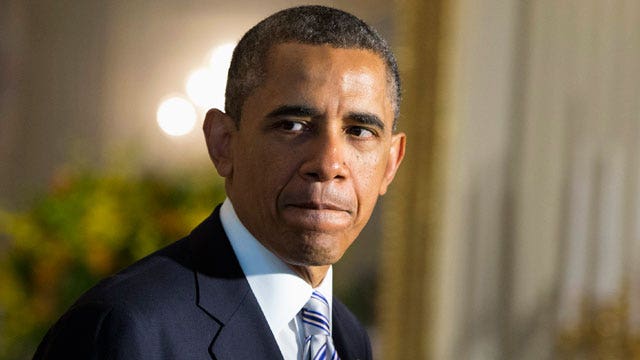Did Obama drop the ball on Syria?
Sen. Rubio says president's inaction has led to 'worst possible scenario' in region
Capitol Hill lawmakers pressed President Obama on Sunday to go beyond supplying Syrian rebels with small arms and to consider imposing a no-fly zone over the war-torn country.
South Carolina Republican Sen. Lindsey Graham said supplying rebels with automatic weapons and ammunition is not enough to stop the regime of Syrian President Bashar Assad.
“We need to create a no-fly zone,” Graham told NBC’s “Meet the Press.” “We cannot take air power out of the equation.”
However, such a decision is not without peril.
Obama has not ruled out imposing a no-fly zone in Syria.
But as a symbol of what can go wrong when the American military gets into a Middle East conflict, his administration points to the 2003 U.S.-led invasion of Iraq that resulted in a prolonged, costly stay in which roughly 4,500 U.S. soldiers were killed.
"We've rushed to war in this region in the past,” Obama Chief of Staff Denis McDonough told CBS' "Face the Nation." “We're not going to do it here."
President Obama decided Thursday to arm rebels trying to overthrow Assad, after saying he had enough conclusive evidence that the Syrian strongman had crossed a “red line” by using chemical weapons on people in the 2-year-long civil war in which 93,000 people have been killed.
Graham and others think Assad’s superior air power – in addition to support from Russia and the terror group Hezbollah -- has recently helped tip the balance of power in his favor and question whether Obama’s decision last week might be too little, too late.
Graham was joined on the show by Georgia Republican Sen. Saxby Chambliss, who said the United States’ position must be based essentially on daily evaluations of the military situation in Syria.
“A no-fly zone may be the ultimate tactic that needs to be taken,” said Chambliss, the highest-ranking Republican on the Senate Intelligence Committee.
Colorado Democratic Sen. Mark Udall took a more measured approach, saying he is considering a range of U.S. responses including a no-fly zone.
“I'm open to all options,” he told NBC.
However, Udall suggested that a no-fly zone and other escalations may lead to a “slippery slope” of getting the U.S. deeply involved in a complex, costly and deadly war.
Graham also argued the ultimate goal in Syria is to achieve a political settlement, as fighting and unrest spills into such neighboring countries as Turkey and Lebanon.
It’s a "powder keg,” said Graham, who with Arizona Republican Sen. John McCain is among the strongest Capitol Hill voices calling for a bigger U.S. role in Syria.
But such an agreement with Assad cannot be achieved as long as he continues to win on the battlefield, he said.
Experts say the White House is looking at the wrong Iraq war when considering a no-fly zone over Syria.
To be sure, the war toppled Saddam Hussein but also sparked widespread sectarian fighting and tensions that still simmer.
However, when considering a no-fly zone, experts point to 1992, a year after the Gulf War. That's when the U.S. imposed a weakly-enforced no-fly zone over southern Iraq and could not prevent Saddam, a Sunni Muslim, from persecuting and killing hundreds of thousands of Shiites whom he viewed as a political threat.
While the White House is undecided on whether to impose the no-fly zone, Egyptian President Mohammed Morsi on Saturday called for one endorsed by the U.N.
Ben Rhodes, the White House deputy national security adviser, said last week: "People need to understand that not only are there huge costs associated with the no-fly zone, not only would it be difficult to implement, but the notion that you can solve the very deeply rooted challenges on the ground in Syria from the air are not immediately apparent."
Supporters of a no-fly zone also point to the one that was established by NATO over Libya in 2011. It overwhelmed Muammar Qaddafi's air defenses and attacked tanks and military vehicles that threatened civilians.
But European nations have shown little appetite for getting directly involved in Syria, where Assad's forces possess an air defense system made far more robust with Russian-bought weapons than what Qaddafi had.
Last month, Russia acknowledged it has agreed to sell Syria advanced S-300 air-defense missiles, which are considered to be the cutting edge in aircraft interception technology and could make a no-fly zone very costly.
Twenty years ago, the U.S. mission in Iraq showed that no-fly zones must be aggressively enforced if they are to work.
Military air units generally need to be working closely with ground forces to make sure that airstrikes and missile attacks hit their intended targets and don't kill civilians.
Creating an effective no-fly zone in Syria would require fighter jets or drones equipped with radar and weapons as well as other surveillance planes, said national security analyst Anthony Cordesman at the Center for Strategic and International Studies. He predicted it probably would have to be done without U.N. support, and it may lead to U.S. troop deaths.
The Associated Press contributed to this report.





